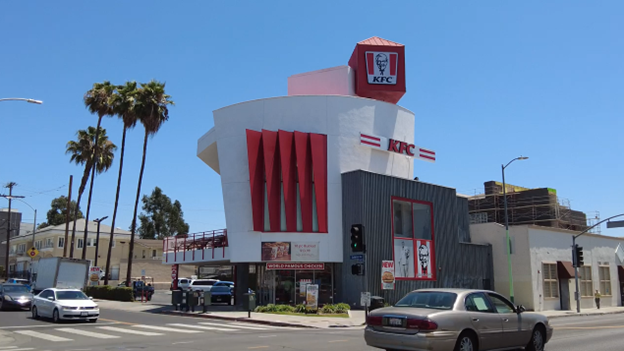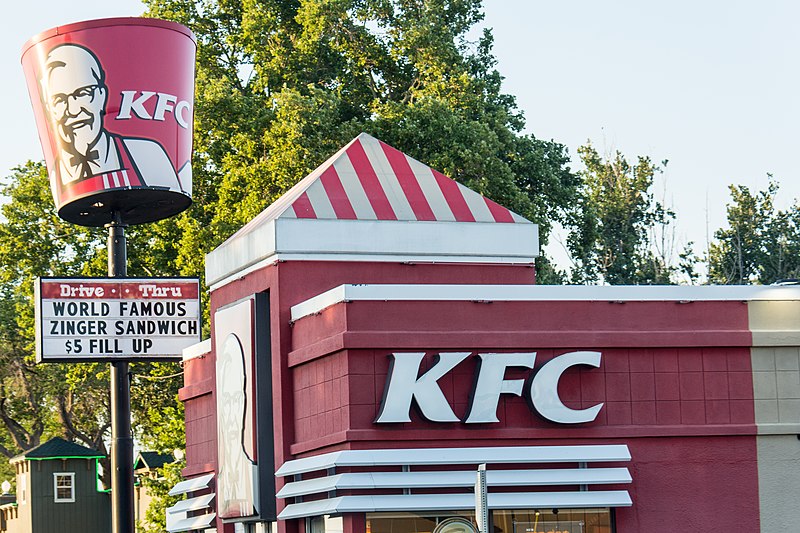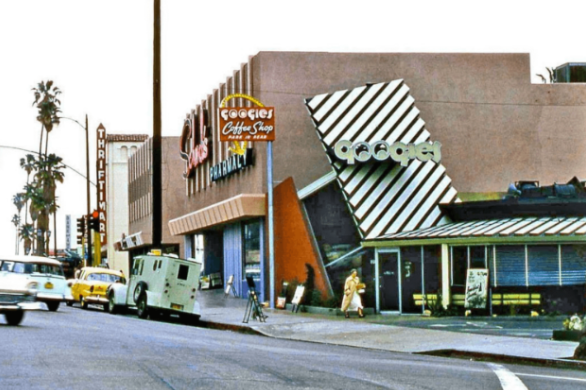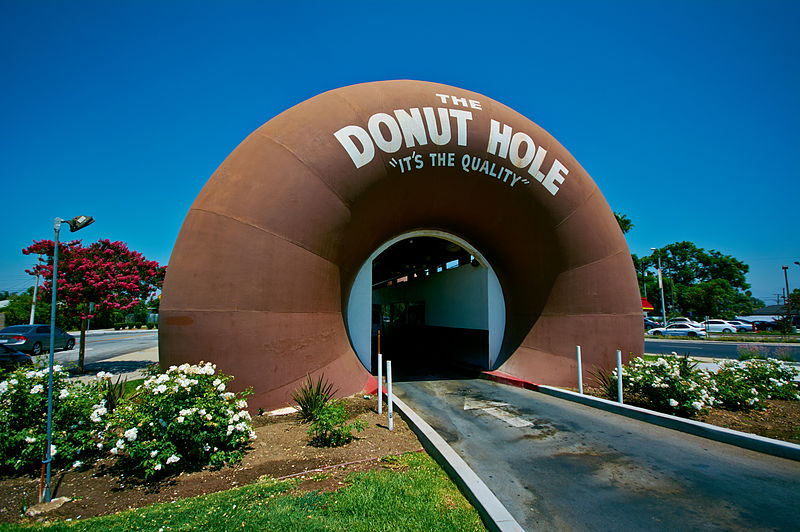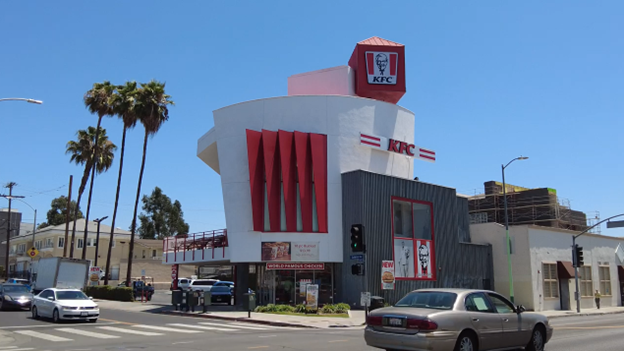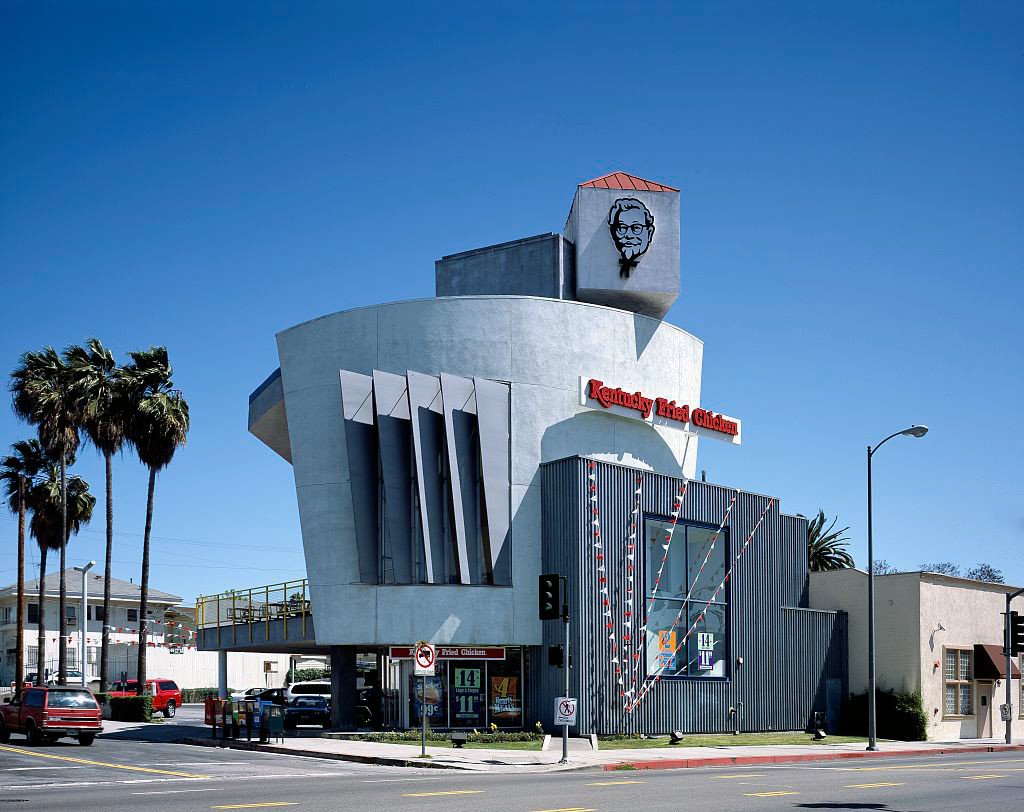
- calendar_month February 4, 2023
- folder Food
Punctuating an admittedly bizarre stretch of Western Avenue, the world’s strangest KFC stands unapologetically. Now, a KFC in Los Angeles doesn’t typically inspire doubletakes. But in that blur of the map where East Hollywood is often mistaken for Koreatown looms one of the most futuristic buildings in the city. And, again, it’s a KFC. We’re betting you’ve seen a KFC before. Typically, they look cookie cutter. Same faux mansard roof. Same cupola. And, of course, there’s the sign with the giant bucket, presumably of chicken, beaming Colonel Sanders’ face to hungry motorists. Just not on Western Avenue. That’s because one franchise owner opted for a more dystopian model. So, today, we’ll struggle to answer the age-old question: what’s up with that weird KFC on Western?
What Makes This KFC So Unlike the Others?
Photo credit: Zed Adams
Some Angelenos swear designers modeled this Googie-influenced scion of futuristic buildings to look like a two-story bucket of chicken. Others claim it’s meant to look like a monstrous deconstructed chicken itself. You don’t have to squint your eyes to see either one. The section most often mistaken for a bucket is further accentuated by vertical steel beams serving to shade a series of slender windows.
Behind the “bucket”, a series of floor-to-ceiling windows gazes beyond the second floor seated balcony to the Hollywood Hills in the distance. A parking lot is inconspicuously tucked away, allowing this odd KFC an undiluted, in-your-face platform for passing traffic.
Echoes of the classic KFC gently radiate from a mock cupola crowning the establishment. And emblazoned on this geometric facsimile is an Orwellian glowing visage of Colonel Sanders. Big Colonel is watching.
Photo credit: m01229
Inside, you’ll find the same fast food fried chicken with the same 11 herbs and spices. But when you order your food at the register, it’s delivered to the upper level dining area by dumbwaiter. There’s even an anxiety-inducingly tight drive-thru.
There have been thousands of KFCs built since the early 1950s. And while they didn’t all adhere to the standard model, none of the other locations could be considered futuristic buildings. So, the question remains: why? To get the answer, we need to take a trip back to 1989.
Don’t Threaten Us With a Googie Time
A Honda Accord blasting Poison’s “Every Rose Has Its Thorn” cut off a Ford Escort on a nondescript stretch of Western Avenue. In response to a nearby boombox broadcasting the Dodgers game, a passing pedestrian cursed under his breath. The team were having an off year, inching into fourth place of the Western Division. Newspaper headlines trumpeted that violent crime was surging in the valley. And Jack Wilke was on the phone with KFC corporate headquarters with a bold new idea.
Photo credit: Modern Living LA
If it wasn’t for Wilke’s grand vision (and love for Googie architecture) the weirdest KFC would have never existed. Somehow, he got the company to approve his dream. Now, he needed to convince renowned architects Elyse Grinstein and Jeffrey Daniels. Running their own firm, Grinstein + Daniels Architects, they likely never expected to be commissioned to design a KFC. And when Wilke called with his proposition, the architects were on the verge of declining.
But Wilke knew his architecture. And when he dropped the name of legendary architect John Lautner, who had famously designed the iconic Googies Coffee Shop that became the namesake of an entire design style, Daniels curiosity was piqued.
Wilke elaborated that he’d partially chosen the architect duo because Grinstein had previously worked with Frank Gehry. This along with the firm’s reputation convinced Wilke that they’d be perfect for bringing his Deconstructivist dream to cold, hard tangibility. He described to them a structure that paid tribute to the Googie buildings of old but with a contemporary new wave twist. Grinstein and Daniels accepted.
Creating One of the Most Futuristic Buildings in LA Was Never Programmatic
Photo credit: George Cummings
The architects wasted no time. By 1990, one of the most futuristic buildings in LA punctuated Western Avenue. It was immediately lumped in with examples of Programmatic Architecture; a design style by which buildings advertise their products with their actual shape. Think the Donut Hole; a donut shop with a drive-through coercing cars through the center of literal giant donuts. Some saw the building as a geometrically basic representation of a giant chicken. Others saw it as a space age fried chicken bucket.
The truth is that the Programmatic nature was always in the eye of the beholder. Speaking with Los Angeles Magazine, Daniels admitted that the chicken references were never a conscious effort. Rather, the major influences remained Deconstructivism and classic Googie architecture.
In the end, the answer is almost as simple as the question. Why is the KFC on Western Avenue so weird? Because franchise owner Jack Wilke had eccentric tastes.
A Still-Standing Legend of East Hollywood
Photo credit: jonburrows
Though the world around one of the most futuristic buildings in LA has changed a lot, the structure itself hasn’t other than some fresh paint. Even a few years ago when a small structural fire sparked on the second level, it wasn’t enough to rob us of one of the city’s oddest designs.
To this day, some come for the fried chicken. Some come for Deconstructivist architecture. Maybe some even come to fantasize they live in a dystopian future in the grip of Colonel Sanders’ iron fist. But no matter why they come to one of the most futuristic buildings in California, we know they leave with more questions than answers.
But don’t let the truth deprive you of wonder. It’s still one of the strangest things you’ll see on Western Avenue. And that’s saying something!
